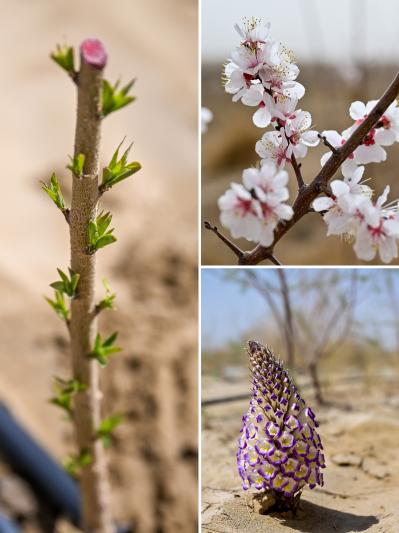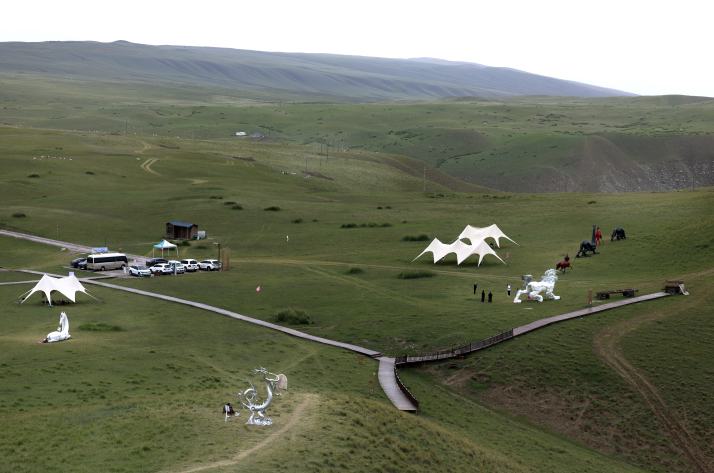| Xinjiang Today |
| Hetian Prefecture: taming the desert | |
|
|
 A renovated street in downtown Hetian City, capital of Hetian Prefecture, on June 2024 (XINHUA)
On November 28, 2024, as the final rose sapling was planted in Yutian County, Hetian (Hotan) Prefecture in south Xinjiang, the green barrier encircling the Taklimakan Desert for over 3,000 km was officially completed. Today, over 90 percent of the saplings have survived, an impressive rate, forming a resilient green defense line along the edge of China's largest desert.
Hetian Prefecture, nestled against the towering Kunlun Mountains on the south, extends northward into the Taklimakan. Mountains account for 33.3 percent of the land of the prefecture, deserts 63 percent and oases 3.7 percent. It is among China's most severely sandstorm-affected regions, characterized by frequent sand movements, profound ecological damage and a large affected population. The prefecture has been proactively tackling desertification with consistent long-term planning. "We have achieved a transition from 'deserts advancing as humans retreat' to 'green areas advancing as deserts retreat'," said Mahmut Umarjan, Commissioner of the Hetian Prefectural Administrative Office, at a press conference in August. Currently, the prefecture's oases have over 32 percent forest coverage, while the number of days with excellent air quality has also increased by 32 compared with a decade ago.  A car races during the Taklimakan Rally in Yutian on May 27 (XINHUA)
Desert industries "Combating desertification is not just an ecological mission but also an economic endeavor benefiting people's lives," the commissioner said. "Hetian Prefecture has integrated ecological restoration with desert industry development, launching projects in livestock breeding, cash forestry and desert tourism."  Rose buds (left), almond blossoms (upper right) and desert ginseng (XINHUA)
The prefecture grows medicinal herbs extensively, mostly the desert ginseng or Cistanche deserticola, Chinese cucumber (Trichosanthes kirilowii), and roses. The desert ginseng is prized in traditional Chinese medicine (TCM) for relieving constipation and boosting immunity. The Chinese cucumber—valued for its fruit, seeds and roots—boosts respiratory and cardiovascular health. Roses are used to alleviate pain and improve blood circulation. They also play an indispensable role in preventing desertification, said Pang Yongming, Deputy Director of the Industry and Information Technology Bureau of Hetian Prefecture. According to him, Hetian Prefecture's rose output was worth 110 million yuan ($15.4 million yuan) last year. This year, it is projected to hit 284 million yuan ($39.8 million). Local communities have developed drought-resistant, highly adaptable rose varieties. The flowers are harvested at dawn and processed within 12 hours to make over 70 derivative products such as distilled essential oils, scented teas, hydrosols for beauty products, and even rose-flavored naan, a type of flatbread that is a Xinjiang specialty. These products are sold nationwide on e-commerce platforms. The medicinal herb initiative has created 12,600 stable jobs and 53,500 flexible employment opportunities. The herb output is projected to exceed 722 million yuan ($101 million) this year, turning resources into prosperity for local communities. Over 30 companies in Hetian Prefecture make TCM drugs or are involved in other TCM work. It also has two TCM industrial parks, two medicinal herb markets and four herb planting bases. This integrated planting-processing-marketing chain ensures stable income for farmers.  Drip irrigation is used on an alfalfa farm in Hetian County on September 9 (XINHUA)
Public participation Hetian Prefecture gives priority to public participation in the desertification control work. Since last year, over 700,000 locals took part in afforestation, which generated 836 million yuan ($117 million) for the workforce. Additionally, the region has rolled out a land contracting policy to ensure benefits for the villages. Over 39,000 hectares of land was allocated to 795 villages, benefiting around 54,000 people. The policy greened the desert, raised farmers' incomes and bolstered the village economy. Traditional sand control strategy—fixing little squares of dry straw and reed onto the dunes to create sand-stabilizing grids, or using longer sections of reeds to create sand barriers—has been deployed. Photovoltaic (PV) sand control is another important initiative. The PV panels generate electricity and reduce the wind speed, stabilizing the sand. In the shadow of the panels, drought-resistant plants are grown, further fixing the sand with their root systems. These measures not only address the challenges of desertification control but also generate economic benefits, transforming desert management from a purely input-driven model to one with sustainable returns. "Hetian Prefecture's development practices have proven that deserts are not obstacles to progress, but opportunities for growth," Mahmut said. He expects that in the near future, the southern edge of the Taklimakan will become a green land with lush forests, redolent with the aroma of fruits.  A scenic spot in the Kunlun Mountains in Cele County on August 6 (XINHUA)
Hetian Prefecture Quick Facts Area: 247,400 square km Population: 2.5 million GDP (2024): 59.8 billion yuan ($8.4 billion) Administrative Divisions: Hetian City, Hetian County, Pishan County, Moyu County, Luopu (Lop) County, Cele (Qira) County, Yutian County and Minfeng County (Source: Hetian Prefectural Administrative Office) Comments to yanwei@cicgamericas.com |
|
||||||||||||||||||||||||||||
|